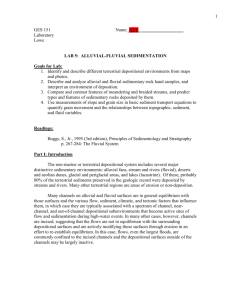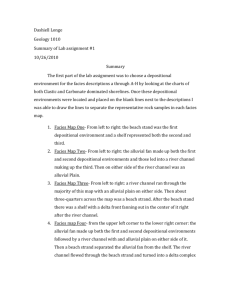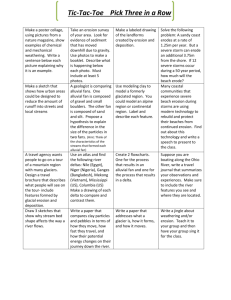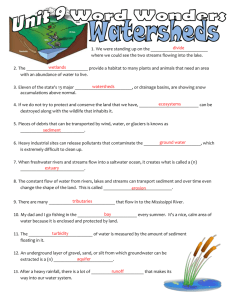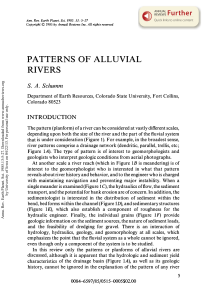Fluvial_Lab_Revised
advertisement
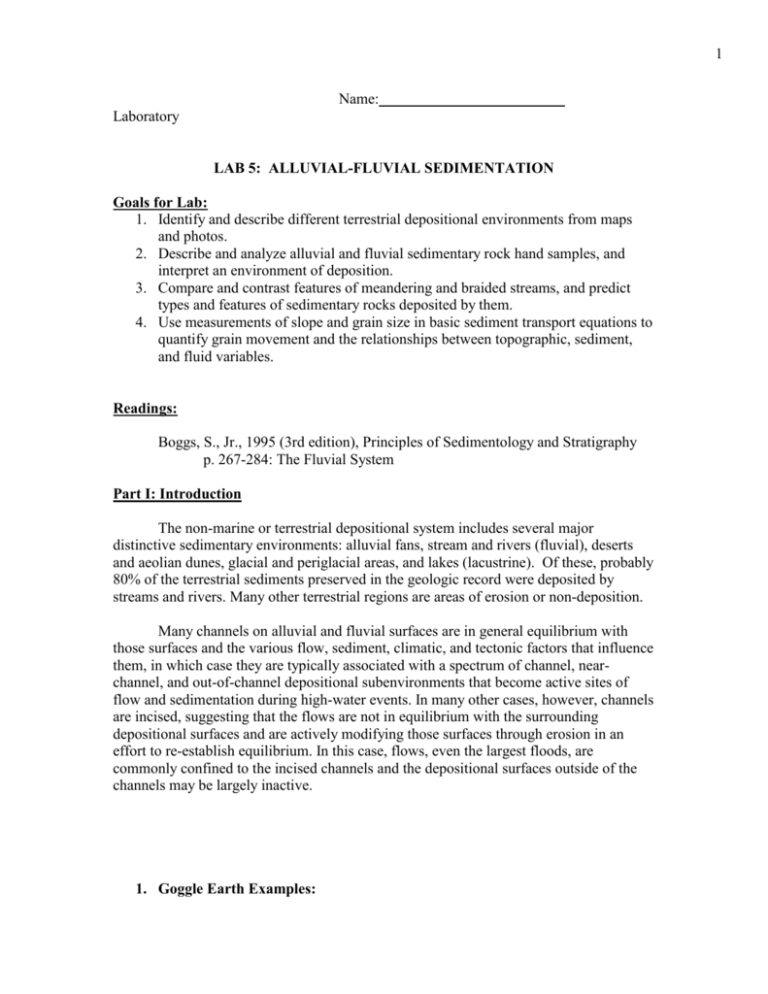
1 Name: Laboratory LAB 5: ALLUVIAL-FLUVIAL SEDIMENTATION Goals for Lab: 1. Identify and describe different terrestrial depositional environments from maps and photos. 2. Describe and analyze alluvial and fluvial sedimentary rock hand samples, and interpret an environment of deposition. 3. Compare and contrast features of meandering and braided streams, and predict types and features of sedimentary rocks deposited by them. 4. Use measurements of slope and grain size in basic sediment transport equations to quantify grain movement and the relationships between topographic, sediment, and fluid variables. Readings: Boggs, S., Jr., 1995 (3rd edition), Principles of Sedimentology and Stratigraphy p. 267-284: The Fluvial System Part I: Introduction The non-marine or terrestrial depositional system includes several major distinctive sedimentary environments: alluvial fans, stream and rivers (fluvial), deserts and aeolian dunes, glacial and periglacial areas, and lakes (lacustrine). Of these, probably 80% of the terrestrial sediments preserved in the geologic record were deposited by streams and rivers. Many other terrestrial regions are areas of erosion or non-deposition. Many channels on alluvial and fluvial surfaces are in general equilibrium with those surfaces and the various flow, sediment, climatic, and tectonic factors that influence them, in which case they are typically associated with a spectrum of channel, nearchannel, and out-of-channel depositional subenvironments that become active sites of flow and sedimentation during high-water events. In many other cases, however, channels are incised, suggesting that the flows are not in equilibrium with the surrounding depositional surfaces and are actively modifying those surfaces through erosion in an effort to re-establish equilibrium. In this case, flows, even the largest floods, are commonly confined to the incised channels and the depositional surfaces outside of the channels may be largely inactive. 1. Goggle Earth Examples: 2 The following alluvial and fluvial channels represent one of these types. Identify the type of channel (equilibrium or incised) and briefly describe the observational evidence for your answer. (Hint: You may want to tilt the view and increase the vertical exaggeration to get a better view.) a. Alluvial fan: Death Valley b. Braided river: Brahmaputra c. Meandering river: Mississippi d. Braided river: Platte e. Alluvial fan: New Mexico f. Meandering river: Cascades g. Braided river: Upper Pecos h. Meandering river: Lower Pecos 2. What factors may affect large depositional systems like these to upset the equilibrium between the flows and the depositional surface and cause channel incision? How might the rate of incision change over time? 3 Part II: Alluvial Fans Alluvial fans are wedge-shaped accumulations of sediment deposited at mountain fronts. They develop as the mountain streams, which are generally erosive in character, leave the steep, confined mountain valleys and pour out into adjacent low-gradient, open basin floors. The drop in competence and capacity accompanying such a change in gradient and transformation from confined to unconfined flows results in the rapid deposition of the coarsest part of the sediment load. Alluvial fans include several subenvironments. Large parts of the fan surface are inactive over long periods of time. The active area of the fan commonly includes an incised fan-head channel, which is often an avenue of transport rather than a site of deposition; a mid-fan area of braided anastomosing and bifurcating channels where most coarse sediment deposition occurs; and a lower-fan region where channels are indistinct and runoff is commonly largely sheet-flooding. Sediment deposited on alluvial fans is usually the coarsest material moved by the mountain streams because fine-grained sediment, including much sand, silt, and clay, passes through the alluvial-fan system entirely and is moved out onto the basin bottom or into connecting rivers. Much of the sediment on arid-climate alluvial fans is deposited by flash floods and debris flows. Thus many alluvial fan deposits consist almost entirely of gravel. The term fanglomerate has been applied to coarse, gravel-sized alluvial fan deposits. Because of the rapidity of deposition, these deposits are typically crudely stratified and poorly sorted. The lateral impersistence of beds and evidence for scour are abundant. Alluvial fan deposit, Death Valley 4 The following questions refer to the large, young, symmetric alluvial fan developed at the mouth of Victorio Canyon, Victorio Peak 7 1/2-minute quadrangle, west Texas (see Google Earth .kmz file). In working with natural sediments in rivers, streams, and canals, it is often necessary to calculate whether particles of a given size will be eroded by normal flows. In other cases, it is important to know the largest particles that can be eroded by a given flow. In calculating sediment erosion, we use a graphical summary of the dimensionless relationship between sediment grain size, d, and the friction that a flow exerts on the bed over which it moves, called shear stress, o. This summary is called a Shield's diagram. It does not simply plot grain size versus friction force because such a graph would apply to only one stream or flow, and a new plot would have to be generated for every different type of system. Instead, scaling and geometry problems can be eliminated by incorporating appropriate variables along with grain size and shear stress. The variables plotted are formulated to be dimensionless (all of the fundamental length, mass, and time units cancel), meaning that the results apply in both cgs and English systems. Shield's diagram shows a simple curve that represents all of the points at which sediment of a given size is eroded under a given set of conditions. Points lying above the curve are within the transport field: sediments of a given size that plot above the curve in a given stream will be moving along the bed or in suspension, not lying on the bed. Points lying below the line are within the "no movement" field: sediments that plot below the line under a given set of hydraulic conditions will remain at rest on the bed and not be eroded. The extreme coarseness of the debris making up alluvial fans can be appreciated by considering the erosive power of the intermittent streams flowing within the fan channels. Shield's diagram provides a means of estimating the erosive power of fluid flows. This diagram represents a graph of two dimensionless variables, q and R: q is a function of o and R is a function of particle size, d. q = (o)/g(s-f)d and R = (u*fd)/µ where o = boundary shear stress g = acceleration due to gravity = 980 cm/sec2 f = fluid density = 1.0 gm/cm3 s = particle density = 2.65 gm/cm3 d = particle diameter in cm u* = shearing stress velocity (cm/sec) = √o/f µ = fluid viscosity = 0.011 gm/cm sec for H2O. 5 The boundary shear stress (o) is a measure of the frictional force in units of force/unit area exerted by the fluid on the bed over which it moves. It can be calculated from the relationship o = fgDS where D = flow depth in cm S = slope = tan (slope angle) Shearing stress velocity, u*, is defined as √o/f. It is not a real velocity measure but has the units of velocity (cm/sec). It is recognized as a separate variable simply because the term √o/f appears frequently in hydraulics calculations. It can be calculated from u* = √gDS These equations will be derived in class from simple dynamical relationships. Note that all of the variables can be calculated from basic measurable properties of the system: fluid density, acceleration of gravity, flow depth, slope, particle size, and water viscosity. Hence, they have wide application. A. You will need to calculate the fan slope along the main channel between the points A and B in Google Earth. Calculate slope as vertical drop/horizontal distance. During flood periods, water commonly pours through the fan channel at depths of 1.5 m or more. Using Shield's diagram, calculate the size of the largest clasts that could be moved within the channel by a flow 1.0 m deep between the 4080 and 4000-foot contours. Note that above R = 1000, the value of q at which erosion occurs has a constant value of 0.06. Hint: Calculate the values of the dimensionless variables in Shields diagram, q and R, assuming some arbitrary value for d, grain diameter. Refer to the diagram to see if the calculated values represent a point in the field of transport or a point below the erosion curve. By choosing new values of d, you can by trial-and-error arrive at a final value that identifies a point on the erosion curve that represents the coarsest material erodible by the flow. 6 B. You have now done some basic calculations of erosive power for the upper and middle parts of this alluvial fan. Discuss briefly the relationships that you might expect between slope and the coarseness (grain-size) of the sediment that you would expect to accumulate on the various proximal to distal parts of the fan. Try to explain the relationship between the changes in slope from mountain front source area to the basin floor. Is the slope uniform, progressively changing, or discontinuous? And why? Give this some careful thought. 7 C. Examine the specimens of alluvial fan material provided. Briefly summarize their collective (not individual) characteristics in terms of sediment size, shape, sorting, packing, and composition. Are these samples texturally mature or immature sediments? Are they compositionally mature or immature? Specimens TX-4-2 UT-21 X-19 UT-20-1 8 Part III: Meandering Rivers Meandering rivers, or rivers of high-sinuosity, are characterized by looping channels that meander back and forth across a floodplain. The floodplains include not only the channel but associated point bars, levees, and low-energy overbank areas. Deposition occurs both within the channels and, during flooding, outside the channel in levee and overbank environments. The latter commonly include a complex association of lakes, swamps, and intermittently wet areas. Meandering rivers develop where there is an abundance of fine-grained suspended-load sediment. Gradients are extremely low. Over the last 300 miles of its course, the Mississippi River surface drops in elevation by only 20-30 feet. Deposition within the channel and on associated point bars is mainly from bed load but levees and overbank areas accumulate largely suspended load sediment. In the geologic record, meandering river deposits consist of channel sands and fine gravel, usually eroded into older, underlying fine-grained overbank deposits, grading upward into fine-grained sandy and silty levee deposits and finally into clay, silt, and fine sand overbank units. These deposits thus form fining-upward cycles having a vertical scale reflecting the topographic relief of the stream system that deposited them. Thus, a channel-point bar-levee-overbank cycle for the Mississippi River, which is commonly 80 to 150 feet deep, might be 80 to 150 feet thick whereas that of a smaller and shallower stream, like the San Joaquin River might be only 10 to 25 feet thick. Meandering river sediments, Triassic, Arizona 9 Two suites of hand samples are provided representing ancient meandering stream deposits. One drawer includes materials collected from fluvial sequences in Utah (latest Cretaceous and Paleocene) and Scotland (Devonian) that probably represent temperate or moist climate units. The other drawer contains specimens from the Pennsylvanian of Colorado. The Pennsylvanian climate here was one of extreme aridity. Utah Cretaceous/Paleocene UT-21-1 UT-X SCT-17 SCT-7-1 WAL Colorado Pennsylvanian CL-24-2 CL-26-1 (not a clastic sediment) CL-34-2 CL-34-3 CL-45-2 CL-45-3 CL-56-1 A. Sample descriptions: For each sample, briefly describe the grain size, roundness, composition, and any sedimentary structures and textures present in the sample. 10 B. Depositional environments: Above is a diagram with basic depositional environments associated with a meandering river. Identify where each sample was likely deposited. Compare and contrast the (a) channel deposits and (b) overbank deposits of these two suites of rocks. What features do they have in common and what controls this commonality? In what ways are these suites very different and what factors are probably responsible for these differences? C. Modern Analogues: Considering your answer to B, which modern meandering river that you looked at in Part I might best compare with the Cretaceous/Paleocene of Utah? And with the Pennsylvanian of Colorado? 11 Part IV: Braided Rivers Low-sinuosity channels that show numerous, anastomosing thalwegs divided by longitudinal braid bars characterize braided rivers. Depositional areas outside the channels are often absent, and often deposits predominantly consist of channel lithofacies. Generally, the channels are broad and the streams subject to large changes in flow volume. As they flood, the streams expand by occupying larger and larger channel areas, but never really extend outside of the channels. Braided rivers develop where there is an extreme abundance of bed-load sediment, mostly sand but gravel in some areas. The channels on alluvial fans represent the coarsest braided streams, but lower-gradient rivers can also be braided. Perhaps the best U.S. example is the sand-rich Platte River of Nebraska. Braided river sequences in the geologic record commonly consist of thickly bedded sequences composed largely of gravel and cross-stratified sand. Finer-grained sediment is uncommon but locally present. Braided river sediments, Eocene, California 12 Depositional environments and typical stratigraphy of a sandy braided river. From Lunt et al., 2004, modified from Cant and Walker, 1978. Google Earth example: Donjek and White Rivers The Donjek (X) and White (Y) Rivers in Canada display examples of many terrestrial depositional environments, but are primarily thought of as an excellent examples of braided river system. With a partner, take a tour of the Donjek and White Rivers: A. Identify the headwaters of these rivers. What is a primary source of sediment? What effect does this have on channel pattern downstream? 13 B. Follow the river downstream. How does the river pattern and morphology change? Where are the main areas of sediment deposition and how is sediment being deposited? How does the river morphology change when they merge with each other, and with the Yukon River (Z)? C. Each partner select a section from one of the rivers, approximately 10 km in length, which displays a braided channel pattern, and capture an image of this to add to your answer (One partner take the White and the other take the Donjek River). Estimate width of the braidplain, slope over the 10 km section, number of active channels (channels with active water flow and sediment transport), and associated depositional environments along the section. Then compare with your partner. How are your observations similar or different? What are the possible controls on these channel morphology variables, and what might account for the differences between the rivers that you observe? Could you propose any bounds on these morphologic variables for braided rivers? 14 D. Now, on your own, do a similar comparison between your section of the White or Donjek with the upper part of the Yukon River (before the confluence with the White/Donjek). What differences (channel pattern, morphology, number of active channels, slope, vegetation, areas of deposition) do you observe between these sections? Would you classify the Yukon River as a braided river (explain your reasoning)? Do your bounds from 3) still apply? E. Specimens: Briefly describe the differences between the three braided river samples. Consider grain size, sorting, rounding, structures, and textures. OL: Carboniferous, Appalachian Foreland Collings Ranch: Ardmore basin, OK SN08-010LP: Sierra Nevada, CA 15 Part V: Summary Question (4-6 sentences) From your answers and observations above, briefly comment on the possible controls on channel pattern, as in, what factors determine whether a stream will flow in a meandering, braided, or fan pattern? Describe how the channel pattern might adjust to a change in one of these controls.

